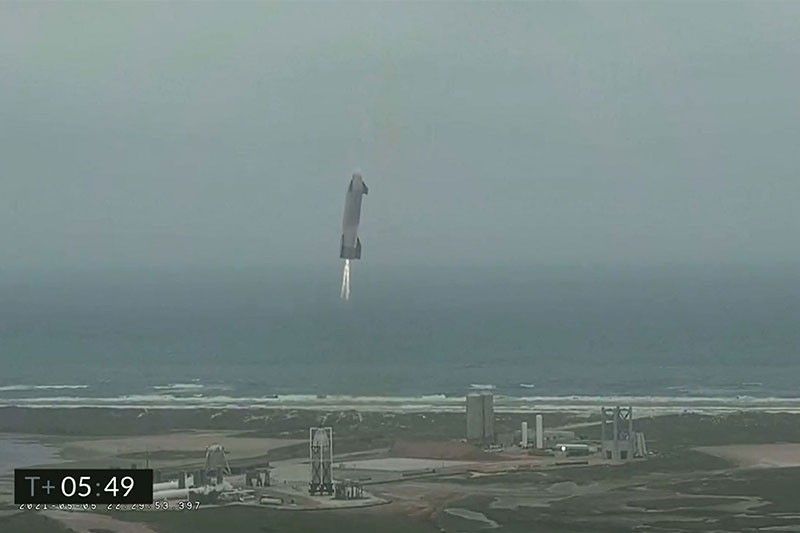Touchdown! SpaceX successfully lands Starship rocket

WASHINGTON, United States — SpaceX managed to land its prototype Starship rocket at its Texas base without blowing it up on Wednesday, the first time it has succeeded in doing so in five attempts.
The test flight represents a major win for the hard-charging company, which eventually wants to carry crew inside Starship for missions to Mars.
"Starship landing nominal!" tweeted founder Elon Musk triumphantly, after the last four tries ended in big explosions.
Starship landing nominal!
— Elon Musk (@elonmusk) May 5, 2021
"Nominal" means normal in the context of spaceflight.
The execution wasn't quite perfect, with a small fire engulfing the base of the 50 meter- (160 feet-) high rocket, dubbed SN15, shortly after landing.
SpaceX webcaster John Insprucker explained this was "not unusual with the methane fuel we're using," adding engineers were still working out design issues.
The flames were quickly put out with water cannons, footage showed.
Earlier, the rocket took off at around 5:25 pm local time (2225 GMT) from the Starbase in Boca Chica in southern Texas, reached an altitude of 10 kilometers (6 miles) and performed a series of maneuvers, including a horizontal descent called a "belly flop."
Live feed of Starship SN15 flight test → https://t.co/Hs5C53qBxb https://t.co/chZjdVAute
— SpaceX (@SpaceX) May 5, 2021
SpaceX was facing added pressure to succeed with Wednesday's flight after NASA last month announced a version of Starship will be used as a lunar lander when the space agency returns humans to the Moon.
But the $2.9 billion contract is currently suspended after two rival companies, Jeff Bezos' Blue Origin and Dynetics, lodged a protest.
Nevertheless, if the award is eventually confirmed, it will transform Starship from Musk's pet project to a major tax payer-funded venture, with all the scrutiny that entails.
The first two flight tests of Starship, SN8 and SN9, both crash landed and exploded when they launched in December and February, respectively.
The next, SN10, successfully landed then blew up a few minutes later on March 3.
The video feed cut out during the test flight of the fourth, SN11, with Musk later confirming it too had exploded, this time in mid-flight.
Eventually, SpaceX plans to combine the Starship spaceship with a Super Heavy rocket, creating a fully reusable system to explore deep into our solar system.
This final version will stand 394 feet (120 meters) tall and will be able to carry 100 metric tonnes into Earth orbit -- the most powerful launch vehicle ever developed.
Musk wants to use this to help realize his goal of transforming humanity into a multiplanetary species with a colony on Mars.
The planned lunar version of Starship would however serve a more modest goal — docking with a future lunar orbital station, collecting astronauts, then setting them down on the Moon.
To get the astronauts to the lunar station in the first place, NASA has a more traditional plan in mind: using its own giant SLS rocket with a crew capsule called Orion affixed on top.
But the SLS rocket has suffered severe delays and cost overruns, and observers have mused if Starship succeeds, it could one day make SLS obsolete.
Monitor major developments on space explorations and the status of missions.
NASA reveals a sample collected from the 4.5-billion-year-old asteroid Bennu contains abundant water and carbon, offering more evidence for the theory that life on Earth was seeded from outer space.
The discovery follows a seven-year-round-trip to the distant rock as part of the OSIRIS-REx mission, which dropped off its precious payload in the Utah desert last month for painstaking scientific analysis.
"This is the biggest carbon-rich asteroid sample ever returned to Earth," NASA administrator Bill Nelson says at a press event at the Johnson Space Center in Houston, where the first images of black dust and pebbles were revealed. — AFP
NASA is set to reveal on Wednesday the first images of the largest asteroid sample ever collected in space, something scientists hope will yield clues about the earliest days of our solar system and perhaps the origins of life itself.
The OSIRIS-REx mission collected rock and dust from the asteroid Bennu in 2020, and a capsule containing the precious cargo successfully returned to Earth a little over two weeks ago, landing in the Utah desert.
It is now being painstakingly analyzed in a specialized clean room at NASA's Johnson Space Center in Houston. — AFP
A Spanish company launches the country's first private rocket on Saturday in a step towards bringing Spain into the exclusive club of space-faring nations.
The launch of the small MIURA1 rocket took place at 02:19 am (0019 GMT) from a military base in the southern region of Andalusia, according to the company, PLD Space.
The company hailed the launch as "successful" and said it had achieved all its "technical objectives". — AFP
India's Sun-monitoring spacecraft has crossed a landmark point on its journey to escape "the sphere of Earth's influence", its space agency says, days after the disappointment of its Moon rover failing to awaken.
The Aditya-L1 mission, which started its four-month journey towards the centre of the solar system on September 2, carries instruments to observe the Sun's outermost layers.
"The spacecraft has escaped the sphere of Earth's influence," the Indian Space Research Organisation (ISRO) says in a statement. — AFP
Carbon dioxide detected on Jupiter's moon Europa comes from the vast ocean beneath its icy shell, research using James Webb Space Telescope data, potentially bolstering hopes the hidden water could harbour life.
Scientists are confident there is a huge ocean of saltwater kilometres below Europa's ice-covered surface, making the moon a prime candidate for hosting extra-terrestrial life in our Solar System.
But determining whether this concealed ocean has the right chemical elements to support life has been difficult. — AFP
- Latest


























